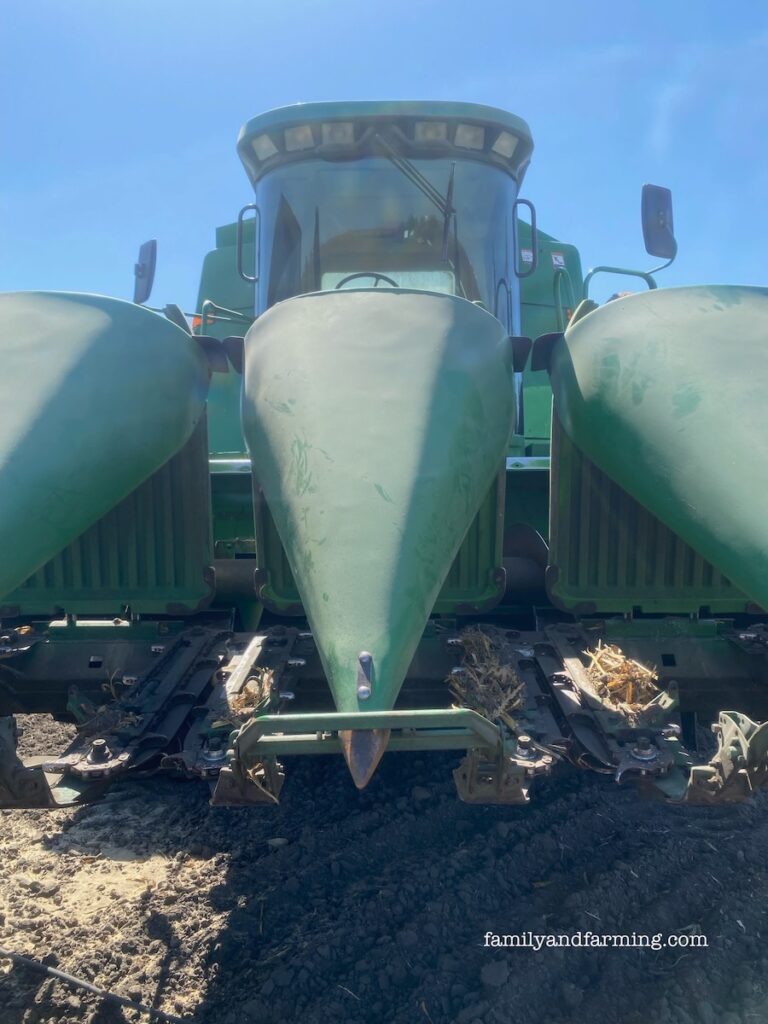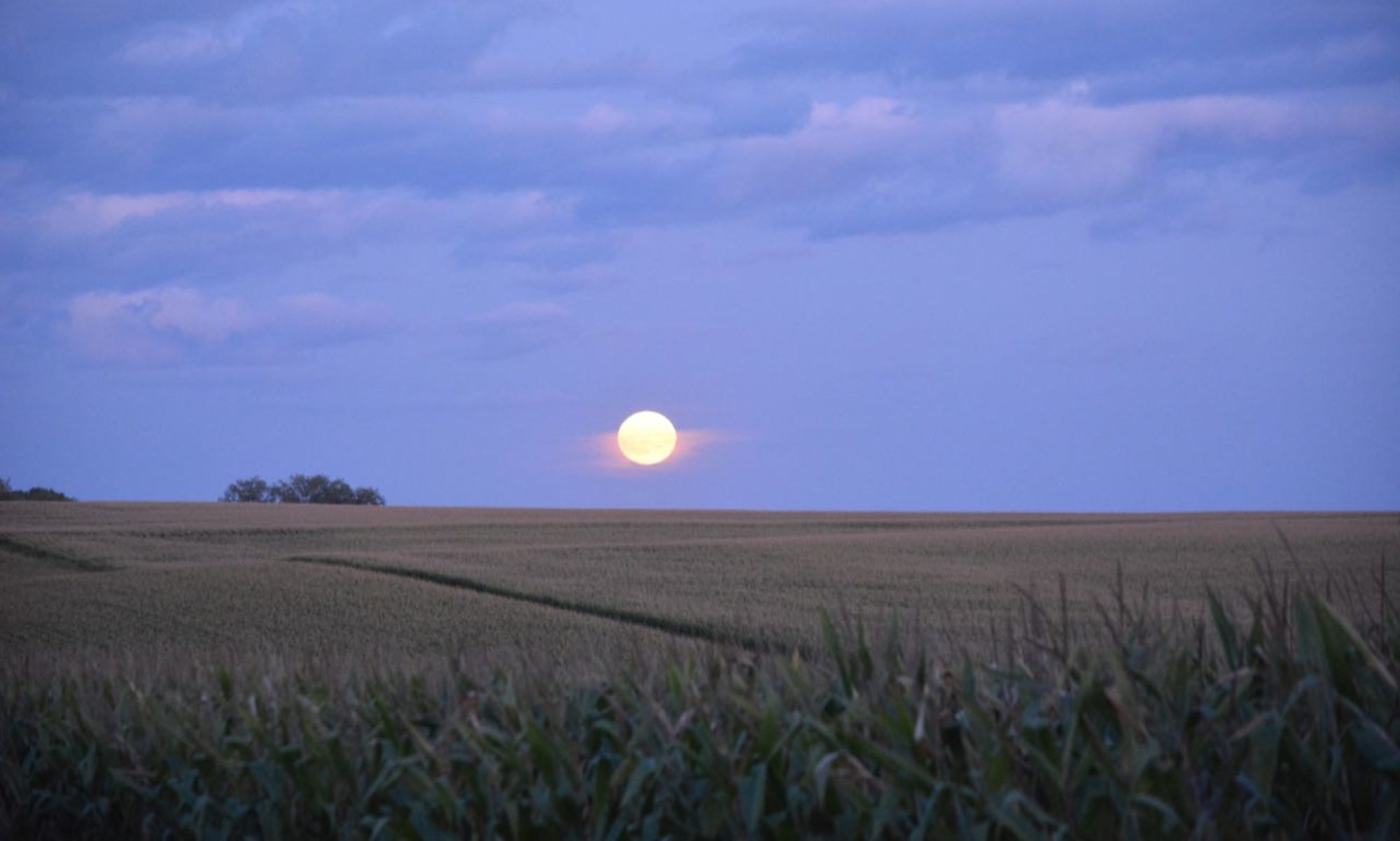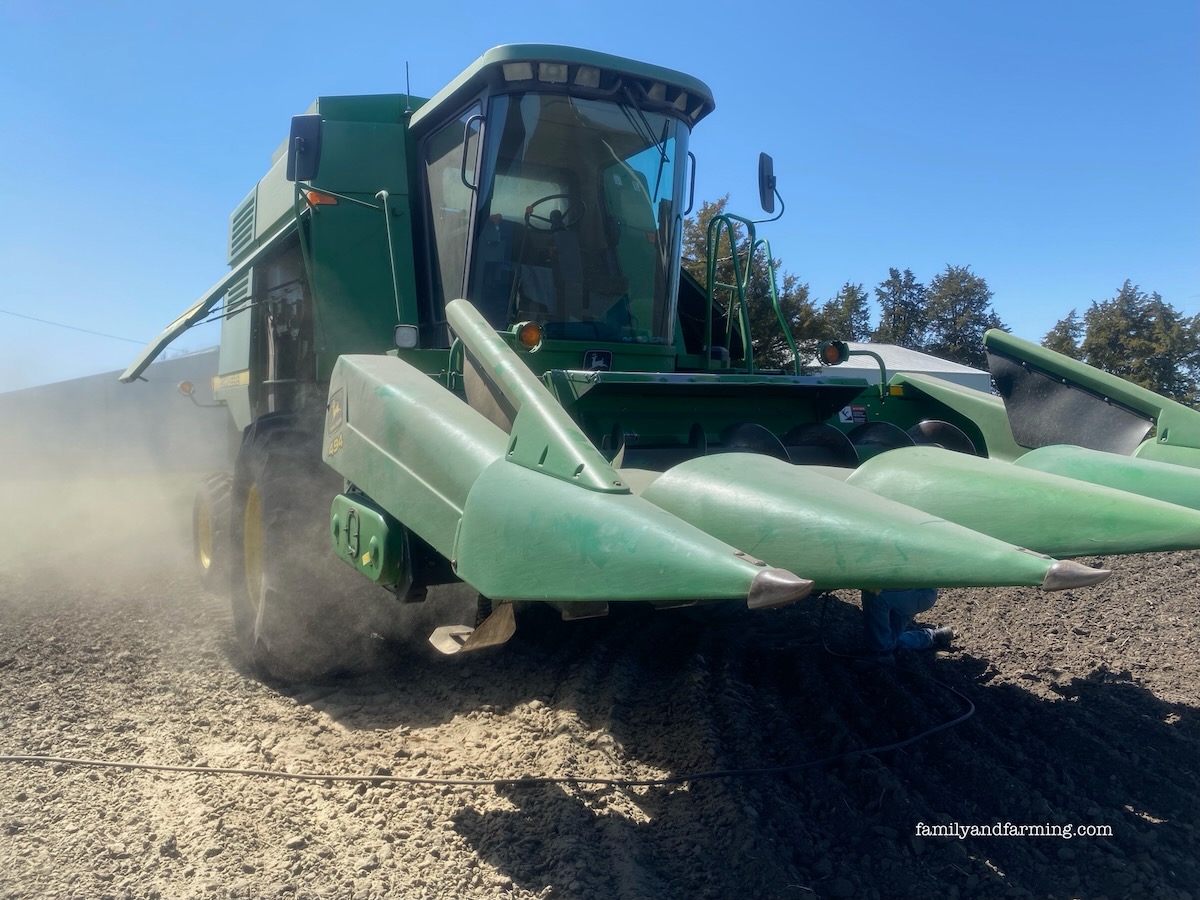Wind conditions are just right to use our air compressor to “dust” the combine. A strong northwest wind is blowing consistently to help me with this three-hour job. Our John Deere 9410 four-row combine is considered vintage, and while it may appear laughable in 2024, it’s OUR vintage combine. We own it and we can repair it at will.
Now hunker down for the longest post I’ve ever written….
Our Right to Repair
I’m using an extended air blow gun attachment connected to our large portable air compressor. My job is to blow all of the dust and chaff from combining the fall harvest out of the machine. I wear gloves, safety glasses, a head wrap and a mask. This will be very dusty work. I’m not blowing soil from the machine. I’m blowing off dust and debris; stuff that could impede the inner workings of the machine next season or start a fire in the combine. It’s just good practice to keep older machinery in top working order.

Not only do we keep things clean, we also replace any worn belts and parts, and keep things well-greased. Keeping equipment in good working order and important parts well-greased is imperative when operating older machinery.
We have the Right to Repair all of our equipment due to the age of everything we have. Right to Repair is an Ag-related phrase many of you may be unaware of, but is an issue that farmers have to contend with.
Our fleet of machinery is entirely John Deere. Our tractors, combine, skid loader, planter, field cultivator, rotary mower, disk, and grain drill are all John Deere. And they are all old. As I’ve mentioned before, we missed the memo to buy new machinery. By missing the memo, we also slipped past the Right to Repair issues other farmers are experiencing for our equipment.

What is Right to Repair?
In the 1990’s the EPA set emission standards, which led a revolution in farm equipment manufacturing, creating farm machines that now are more electronic than mechanical. Our equipment is very much mechanical. There are a few electronic components, but elbow grease and metal parts are key equipment repair items.
If a farmer has a piece of equipment manufactured after 2014, they may not be able to fix it without having a technician come to the farm armed with a computer to assess the issue. Gone are the days of farmers fixing their own new equipment without either employing a technician, or paying thousands of dollars for a yearly diagnostic subscription. Some farmers have gone to leasing big equipment for two years at a time to have a warranty and easier access to technicians and parts. The big equipment is then traded in for another “lease to never own” bigger piece of equipment. Those monthly “lease to never own” payments are larger than most mortgages. Now multiply that. You can’t farm with just a tractor. You need “lease to never own” combines, planters, and other things to pull behind that large “lease to never own” tractor.

There have been lawsuits and legislation to give farmers the right to repair, with varying results. But the bottom line is between US government agency mandates and Big Ag entities, we are beyond knee-deep into the Big Ag Era. Many farmers are now in deep water up to their noses treading in the pool of Big Ag. They can’t seem to escape.
Every day I read or hear a journalist bemoaning the scourge of “Big Ag”. I don’t know if they understand how we got there. I will try to explain from a skewed perspective, based on a personal viewpoint that began in the late 1970’s.
Big Ag. A Personal Perspective
Back in the day before the farm crisis of the 1980’s, which was a BLOOD BATH of financial ruin for many farmers, crop yields were lower. Corn yields were around 150-170 bushels per acre, bringing around $1-$1.50 a bushel to the farmer, and soybean yields were 40-50 bushels per acre, selling for $6-$7 a bushel. These prices were BEFORE taking out the expenses to put in, harvest and store the crop.
Corn seed was around $100 a bushel bag, (a bushel weighs about 56 pounds) while a bushel bag of soybean seed was $20-25. Soybean seed was purchased every other year, as seed was re-planted from year to year by using a fanning mill to clean foreign material off of harvested soybeans.
Land sold for $500-$600 an acre, and quite honestly, no one really wanted to be a farmer back then. It was hard physical work, with no air-conditioned machinery and lots of buckets to carry. There were more farmers, but they weren’t big. My dear husband started farming in 1974, working for other farmers with the agreement to use their 4-row machinery to farm his rented 160 acres at $75 an acre, while also raising pigs in non-confinement. (Refer to the bucket statement.) There has never been an inheritance. We thought we could make it work with hard work and my supplemental off-the-farm teacher’s salary. I know, big bucks!

And then Big Ag came in, pushing farmers around with big elbows after the 1980’s kidney-punched farmers.
What were the Big Ag elbows? Seed companies developed new and improved treated products that could handle new and improved weed sprays for the issues farmers were battling since the beginning of time in their fields. A personal example for us was 20 foot tall Giant Ragweed that filled every fence row throughout this farm. (If you have a ragweed allergy, you are probably shivering right now reading this.)
Giant seed companies figured out how to create seed hybrids that could handle Roundup, a weed killer that could handle these ginormous weed issues farmers like us (that’s every farmer) had to deal with. Yields increased steadily, where now my husband using antiquated equipment, can raise an average of 240-270 bushels of corn per acre. There are spots in certain fields with over 300 bushels here and there, and our soybean yields have increased to 70-85 bushels per acre. This is with only rain that falls from the sky. We don’t use irrigation.
Currently, the price of corn is around $4.50 a bushel, while beans are $11.25 a bushel. In the past few years there have been price fluctuations from a corn low of $3.00 (Covid) to a high of $7.50 (severe drought and demand) and a bean low of $10 (Covid) to a high of $17.50 (severe drought and demand). The wild range in prices tend to be based on someone else experiencing a devastating weather event (flooding or famine-inducing drought as example) or war. Not a really great way to realize great profits; the failure of others.
These fantastic results come with a price tag. Seed is now sold as kernels or units, not by the 56- pound bags anymore. Corn seed (80,000 kernels in a bag) is now over $300, and soybean seed (140,000 units) is $140 a bag.
Farmers & Big Ag Copyright Issues
We can’t fan our beans to replant anymore. The seed companies own the copyright to the seed, and if a farmer infringes on that copyright that has been successfully argued in court by reusing that seed, they will be sued and held liable for copyright infringement. That same copyright concept is used by equipment manufacturers to not allow farmers to fix their equipment.
Land prices have gone up exponentially. We are wishing we invested money we didn’t have in $500-$600 an acre dirt back in the day. It’s now around $15,000-$18,000 an acre. Land rent went from $75 an acre to $300-$400 per acre. Long pause. Yields are up, weeds are down, and costs are through the roof!
While blowing off the dust and debris off our 25-year-old combine, I head-swivel as a $700,000 tractor rolls by. Yes, a $700,000 single piece of equipment that can pull a 16-24 row planter that has a price range of $180,000-$500,000. I’ve heard that monthly lease payments (ownership is rare) for such a combination could range from $4,000-$8,000 a month.
How did farming go from the four rows we started and stayed in during the late 1970’s to now? I know average grain yields in Iowa are the same or lower than ours, and we have ancient machines. Plants grow the same whether they were planted with 4 row or 24 row equipment.
By the way, those Giant Ragweeds in the fencerows we used to battle? Those weeds are long gone. But so are the fence rows. Fence rows get in the way of the turning radius of giant 24 row planters. When the fences are taken out, big equipment can shear road ditches and make them smaller and less deep. Ditches keep and hold snow off roads, hold water, and help wildlife. Fence rows and ditches are also a highway for wildlife. (We have kept our fences and ditches. Fences and neighbors are still a good thing.)
In business there is income averaging and economies of scale, but this million-dollar No Right to Repair machinery and farm ground math makes no sense to me. Does it to you? The cost to farm per acre is the bottom line when figuring farm income. Those costs per acre expenses (inputs) are seed, fertilizer, equipment, storage, fuel, labor, and machinery. Can you see where most of the math is out of wack?
If you scroll back up to my reference to the EPA emission standards and farm equipment becoming rolling computers, things have gotten bigger and bigger. John Deere is now a tech company; with heavy investments in AI, machine learning and a partnership with SpaceX.
Who in the End Pays for Big Ag?
All of these personal insights bring to light a possible paradigm that may end in a heap. This new-fangled paradigm is a combination of government regulations, technological innovations with huge price tags, greed, the need for “cheap food”, wild weather, war, famine, and farmers needing other farmers to fail in order to make a higher profit to swim out a little further from the debt pool they are in, while billionaires ride rocket ships to outer space.
It is not lost on me that I took photos of our ancient combine with my iPhone, wrote this on a MacBook and will post these thoughts on the internet. It’s all a slippery slope isn’t it?
These thoughts make me harken to Ecclesaisticus 21:10, “The way of sinners is made plain with stones, but at the end thereof is the pit of hell.” Or as we all like to say, “The road to hell is paved with good intentions.”
I take a break to eat a late lunch. I have to shower before I can eat. Even with the safety glasses, head wrap and a mask, I am covered with dust. While I sit outside to eat, I wipe away a couple tears as I realize we are a very tiny cog in a very big wheel that will roll over us someday.

Be Blessed.
Discover more from Family and Farming
Subscribe to get the latest posts sent to your email.

